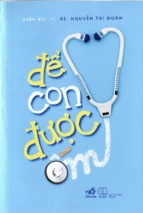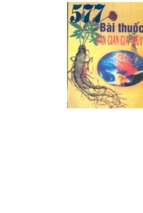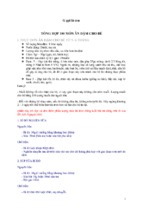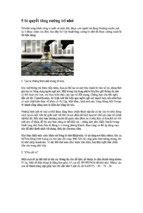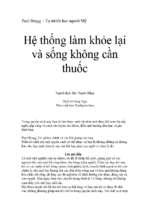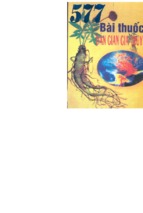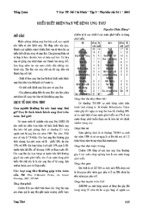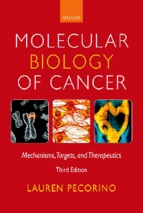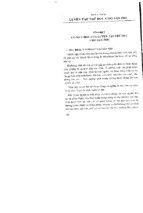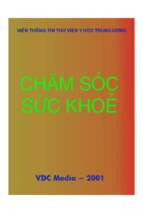Molecular biology of cancer (Lauren Pecorino)
Molecular Biology of Cancer
This page intentionally left blank
Molecular Biology of Cancer
Mechanisms, Targets, and Therapeutics
THIRD EDITION
Lauren Pecorino
University of Greenwich
1
1
Great Clarendon Street, Oxford, OX2 6DP,
United Kingdom
Oxford University Press is a department of the University of Oxford.
It furthers the University’s objective of excellence in research, scholarship,
and education by publishing worldwide. Oxford is a registered trade mark of
Oxford University Press in the UK and in certain other countries
© Lauren Pecorino 2012
The moral rights of the author have been asserted
First Edition copyright 2005
Second Edition copyright 2008
Impression: 1
All rights reserved. No part of this publication may be reproduced, stored in
a retrieval system, or transmitted, in any form or by any means, without the
prior permission in writing of Oxford University Press, or as expressly permitted
by law, by licence or under terms agreed with the appropriate reprographics
rights organization. Enquiries concerning reproduction outside the scope of the
above should be sent to the Rights Department, Oxford University Press, at the
address above
You must not circulate this work in any other form
and you must impose this same condition on any acquirer
British Library Cataloguing in Publication Data
Data available
Library of Congress Cataloging in Publication Data
Library of Congress Control Number: 2012932747
ISBN 978–0–19–957717–0
Printed in Italy on acid-free paper by
L.E.G.O. S.p.A.—Lavis TN
Links to third party websites are provided by Oxford in good faith and
for information only. Oxford disclaims any responsibility for the materials
contained in any third party website referenced in this work.
This book is dedicated to my mentors:
Raffaela and Joseph Pecorino
Professor Frank Erk
Professor Sidney Strickland
Professor Jeremy Brockes
In memory of:
Marie Favia
Mildred Maiello
Kerry O’Neill
This page intentionally left blank
■ P RE FACE
Molecular Biology of Cancer: Mechanisms, Targets, and Therapeutics is
intended for both undergraduate and graduate-level students (including
medical students) and employees in the pharmaceutical industry interested in learning about how a normal cell becomes transformed into a
cancer cell. Signaling pathways of a cell detect and respond to changes in
the environment and regulate normal cellular activities. Cells contain
many receptors on their membrane that allow a signal from outside the
cell (e.g. growth factors) to be transmitted to the inside of the cell. Signaling pathways are composed of molecules that interact with other molecules, whereby one triggers the next in a sequence, in a way similar to the
actions of team members in a relay race. The relay of information may
cause a change in cell behavior or in gene expression, and results in a cellular response (e.g. cell growth). Interference in these signal transduction
pathways has grave consequences (e.g. unregulated cell growth) and may
lead to the transformation of a normal cell into a cancer cell. The identification of the malfunctions of specific pathways involved in carcinogenesis
provides scientists with molecular targets that can be used to generate
new cancer therapeutics. I have chosen to present the biology of cancer
together with a promise for its application towards designing new cancer
drugs. Therefore, for most chapters in the text, the first half discusses the
cell and molecular biology of a specific hallmark of cancer and the last
half of the chapter discusses therapeutic strategies. To help form a link
between particular molecular targets discussed in the first half of the chapter and the therapeutic strategies discussed in the last half of the chapter, a
target symbol () is shown in the margin. I hope that this presentation
stimulates interest and motivates learning of the subject matter.
Several new topics have been added to this third edition. They include:
an update on the hallmarks of cancer, chromothripsis, strategies that target DNA repair, microRNAs, and reprogramming energy metabolism.
Deservedly, a section on the immune system has been added to the chapter
on infection and inflammation and a section on pharmacogenetics has
been added to the discussion about the cancer industry in Chapter 12, a
chapter that may be valuable for special career interests and supplementary for some cancer courses. The final chapter, “Cancer in the future”,
focuses on cancer vaccines and technology.
Personally, I believe that the use of diagrams and illustrations is an
extremely powerful tool of learning. A picture paints a thousand words . . .
and more. I strongly suggest that the reader studies and enjoys the figures,
artistically created by Joseph Pecorino. Major points and new cancer
viii
P R E FAC E
therapeutics are illustrated in red, and the target symbol () is used to identify molecular targets. Detailed descriptions of the figures are found in the
body of the text. This edition contains the inclusion of additional color
plates of experimental data.
Several features that are used throughout the text to facilitate learning
and interest are described below:
Pause and think
These features are often presented in the margins of the text and are
designed to engage the reader in thought and to present additional perspectives of core concepts. Many times questions are posed; sometimes
they are answered and other times they encourage the rereading of particular sections of text.
How do we know that?
These features examine experimental evidence from the scientific literature and ask the reader to analyze raw data or understand the details of an
experimental protocol.
Special interest boxes
Shaded boxes are used to highlight special topics of interest such as the
box entitled “Skin cancer” in Chapter 2. They are also used to provide
additional explanation of more complex subjects such as “A little lesson
about ROS . . .” in Chapter 2, and “A little lesson about the MAP kinase
family . . .” in Chapter 4.
Lifestyle tips
These are suggestions about lifestyle choices and habits to minimize cancer risk, based on our current knowledge.
Leaders in the field of . . .
Scientists around the world have made contributions to the concepts presented in this text. Short biographies of several leading scientists, including their major contributions to a particular field of cancer biology, are
presented. This feature is meant to give a human touch to the text. It may
also be used as a tool for professional use and for following a continuing
interest in the research literature. It may be of interest to listen to leading
scientists in a particular subject area by attending scientific conferences.
PREFACE
Analysis of . . .
Specific molecular techniques used to analyze particular biological and
cellular events are described. It is important that science and medical professionals ask themselves “How do we know that?”. Each of the major
concepts underlying our current state of knowledge is the result of numerous experiments that generate data, suggesting possible explanations and
mechanisms of cellular events. The information retrieved is governed by
the techniques that are used for analysis.
Chapter highlights: refresh your memory
Summary points are listed in order to consolidate major concepts and
provide a brief overview of the chapter. These may be particularly useful
for revising for examinations.
Self tests and activities
Several features are included to strengthen your understanding of particular concepts presented in the chapter: Self tests presented within the text
ask you to immediately reinforce material just presented and often refer to
a figure. This causes a break from reading and engages you, the student, in
“active” learning. Activities that are aimed at strengthening your understanding of particular concepts and encouraging additional self-centered
learning are presented towards the end of a chapter. Some require webbased research, while others are more reflective. Multiple choice questions
can be found on the companion website.
Further reading is a list of general references found at the end of each
chapter. These references consist mostly of reviews and support the contents of the chapter. They are not referenced in the main body of the
text.
Selected special topics mainly lists specific primary research papers that
are referenced in the main body of the text and may be pursued for further
interest. Several relevant web sites are also included.
Appendix 1 is a summary diagram that links key molecular pathways to
the cell cycle.
Appendix 2 lists centers of cancer research as a starting point for searching for research posts and employment in the field. Entries are separated
by location (USA and UK).
ix
x
P R E FAC E
Glossary
Over 160 entries are defined in a clear and concise manner in order to provide students with a handy reference point for finding explanations of
unfamiliar words.
It is my hope that the readers of this text will learn something new, become
interested in something molecular, and ultimately, somehow, contribute
to the field of cancer biology. This field is evolving at a tremendous rate,
and so by the time of printing the information contained within these
pages will need to be updated! This does not concern me because my aim
is to present a process of how the pieces of science are put together and
how we may attempt to apply our knowledge to cancer therapies. Many
new drugs will fail but a select few will not. These select few will make
marked improvements in the quality of life for many.
New to this edition
• Updates on the hallmarks of cancer and metastasis.
• New topics covered, including chromothripsis, the therapeutic potential of
gene signatures, microRNAs, and reprogramming energy metabolism.
• Additional background information and enhanced explanation of
immunology.
■ ACK N O W LEDG M E NTS
First, I would like to express my deepest gratitude to Jonathan Crowe,
Commissioning Editor, at Oxford University Press (OUP). I am indebted
to him for his faith that I could turn a one-page proposal into a complete
textbook for the first edition and for his continued support during the
writing of the following editions. He nurtured the synthesis of the book
with special care, and provided a wealth of helpful suggestions and advice.
With love, I thank my father, Joseph Pecorino, for his never-ending
encouragement and I acknowledge his artistic talent used to translate dozens of my stick drawings into precise illustrations for the book during our
visits across the Atlantic Ocean over the years. Stephen Crumly kindly
reproduced the illustrations using his fine skills in computer graphics
under tight deadlines. Thanks to Philippa Hendry, Production Editor, and
her production staff, and Dewi Jackson and Sarah Broadly for additional
assistance at Oxford University Press. I also thank Jayne MacArthur for
her careful proofreading of the book.
Kind appreciation is expressed for the precise and critical comments
given by my official reviewers for the first edition: Tony Bradshaw, Oxford
Brookes University, UK; Moira Galway, St Francis Xavier University,
Canada; Maria Jackson, University of Glasgow, UK; Helen James, University of East Anglia (UEA), UK; and Ian Judson, Cancer Research UK,
London, UK. The value added to the text by these scientists cannot be
underestimated. Their comments have had tremendous impact and provided a foundation for the second edition. Special thanks is expressed for
the critical comments given by my official reviewers for new chapters of
the second edition—Michael Carty, NUI Galway, Irish Republic; from the
UK: Joanna Wilson, Glasgow, Jonathan Bard, Edinburgh, Phillipa Darbre, Reading, Stephanie McKeown, Ulster, Penka Nikolova, KCL, Elana
Klenova, Essex; from the USA: Annemarie Bettica, Manhattanville College, Nancy Bachman, Oneonta, and James Olesen, Ball State University.
Kind appreciation is expressed to my most recent set of reviewers: Roger
Barraclough, University of Liverpool; Helen Coley, University of Surrey;
Meg Duroux, Aalborg University; Paula M. Checchi, University of California, Davis; Jill Johnston, The University of Sydney; Tapas K. Sengupta,
Indian Institute of Science Education and Research (IISER), Kolkata;
Paola Marignani, Dalhousie University; Andrew Sharrocks, University of
Manchester; and Alicia F. Paulson, University of South Dakota.
I thank Rita Canipari, Ken Douglas, Dario Tuccinardi, Ricky Rickles,
Anne Schuind, and Sarah Thurston for providing unofficial scientific
xii
AC KNOW L E DGMEN TS
critical comments to previous editions and Dylan Edwards, UEA, Nicole
Bournias-Vardiabasis, University of Californa at San Bernadino, and
Young-Joon Surh, Seoul National University, for suggestions to previous
editions.
Many improvements in the third edition are a result of casual feedback
from many people from different places—so many thanks to all of you
and apologies to those I have not named. I thank my colleagues, Babs
Chowdhry, Mark Edwards, John Spencer, and Laurence Harbige for suggestions and communicating cancer news. Special thanks also to the Dean
of School, Martin Snowden, for his support of this project. I am thankful
for suggestions and literature reviews from former students of the University of Greenwich, Kenny Pratt, and Stephen O’Grady.
I acknowledge the financial support of the School of Science, University
of Greenwich, and The Biochemical Society to attend the American
Association of Cancer Research (AACR) Annual Meetings over the last
few years. The information gained and contacts made were important
resources for this edition. Appreciation for their kind gestures of support
of this textbook is given to Samuel Adunyah, Meharry Medical College;
David Axelrod, Rutgers; Michael Caligiuri, Ohio State University; Jules
Harris, University of Arizona; and Candace Ritchie, Merck, who I met at
these conferences.
Many fellow scientists have made suggestions or other contributions to
the book, including: Jeremy Griggs, several members of the Kuriyan
Laboratory, David Lyden, Weil Cornell Medical College, Gerd Pfeifer,
Mariann Rand-Weaver, and Jerry Shay. Special thanks are expressed to
Andrea Cossarizza, Sarah Cowan, Xiuhuai Liu, M.-A. Shibata, and Kelly
Dobben-Annis for helping me to obtain electronic figures. The Royal Society of Medicine Library, London, provided an ideal scientific sanctuary.
I am especially grateful to the support that came from my family, especially Raffaela Pecorino and Teresa Rapillo, and from friends. I am grateful for the tremendous support given by Marcus Gibson.
I admire and acknowledge the work of all those scientists whose
research efforts have contributed to the field of cancer research.
■ OUTLINE CONTENTS
1
Introduction
2
DNA structure and stability: mutations versus repair
21
3
Regulation of gene expression
53
4
Growth factor signaling and oncogenes
77
5
The cell cycle
103
6
Growth inhibition and tumor suppressor genes
123
7
Apoptosis
149
8
Stem cells and differentiation
173
9
Metastasis
197
10
The immune system, infections, and inflammation
225
11
Nutrients, hormones, and gene interactions
253
12
The cancer industry: drug development, pharmacogenomics,
and clinical trial design
283
Cancer in the future: focus on cancer vaccines and technology
299
13
1
APPENDIX 1: CELL CYCLE REGULATION
321
APPENDIX 2: CENTERS FOR CANCER RESEARCH
323
GLOSSARY
327
INDEX
337
This page intentionally left blank
■ DETAILED CONTENTS
1
2
Introduction
1.1
What is cancer?
1.2
Evidence suggests that cancer is a disease of the genome
at the cellular level
1.3
Influential factors in human carcinogenesis
10
1.4
Principles of conventional cancer therapies
13
1.5
Clinical trials
15
1.6
The role of molecular targets in cancer therapies
16
DNA structure and stability: mutations versus repair
5
21
22
2.2
Mutations
23
2.3
Carcinogenic agents
25
DNA repair and predispositions to cancer
38
Therapeutic strategies
42
2.5
Conventional therapies: chemotherapy and radiation therapy
42
2.6
Strategies that target DNA repair pathways
47
2.4
4
2
Gene structure—two parts of a gene: the regulatory region and
the coding region
2.1
3
1
Regulation of gene expression
53
3.1
Transcription factors and transcriptional regulation
53
3.2
Chromatin structure
59
3.3
Epigenetic regulation of transcription
60
3.4
Evidence of a role for epigenetics in carcinogenesis
63
3.5
Telomeres and telomerase
66
3.6
MicroRNAs (miRNAs) and regulation of mRNA expression
69
Therapeutic strategies
70
3.7
Epigenomic and histonomic drugs
70
3.8
Telomerase inhibitors
72
Growth factor signaling and oncogenes
77
4.1
Epidermal growth factor signaling: an important paradigm
77
4.2
Oncogenes
86
xvi
DE TAI L E D C ON TEN TS
4.3
5
6
Kinases as drug targets
95
103
5.1
Cyclins and cyclin-dependent kinases (cdks)
104
5.2
Mechanisms of cdk regulation
107
5.3
Progression through the G1 checkpoint
109
5.4
The G2 checkpoint
111
5.5
The mitotic checkpoint
112
5.6
The cell cycle and cancer
114
Therapeutic strategies
117
5.7
Cyclin-dependent kinase inhibitors
117
5.8
Other cell cycle kinase targets
118
5.9
Inhibitors of the mitotic spindle
118
Growth inhibition and tumor suppressor genes
123
6.1
Definitions of tumor suppressor genes
123
6.2
The retinoblastoma gene
127
6.3
Mutations in the RB pathway and cancer
129
6.4
The p53 pathway
129
6.5
Mutations in the p53 pathway and cancer
137
6.6
Interaction of DNA viral protein products with RB and p53
139
Therapeutic strategies
141
Targeting of the p53 pathway
141
Apoptosis
149
7.1
Molecular mechanisms of apoptosis
150
7.2
Apoptosis and cancer
160
7.3
Apoptosis and chemotherapy
164
7.4
8
95
The cell cycle
6.7
7
Therapeutic strategies
Therapeutic strategies
165
Apoptotic drugs
165
Stem cells and differentiation
173
8.1
Stem cells and cancer
174
8.2
Differentiation and the regulation of transcription
184
Therapeutic strategies
189
8.3
Inhibitors of the Wnt pathway
190
8.4
Inhibitors of the Hh pathway
191
8.5
Leukemia and differentiation therapies
192
DE TAILED CONT E NT S
9
Metastasis
9.1
The process of metastasis
198
9.2
Tools of cell invasion: cell adhesion molecules, integrins, and proteases
199
9.3
Intravasation
203
9.4
Transport
203
9.5
Extravasation
204
9.6
Metastatic colonization
205
9.7
Angiogenesis
206
9.8
Other means of tumor neovascularization
212
Therapeutic strategies
212
Metalloproteinase inhibitors (MPIs)
213
9.9
10
9.10 Strategies for restoring metastasis suppressors
214
9.11 Anti-angiogenic therapy and vascular targeting
214
9.12 Targeting several steps of metastasis at once
220
The immune system, infections, and inflammation
225
10.1 The immune system and cancer
226
10.2 Identifying infectious agents as carcinogens
230
10.3 Inflammation and cancer
237
Therapeutic strategies
11
197
243
10.4 A national vaccination program against hepatitis B virus in Taiwan
244
10.5 Eradication of H. pylori and the relationship to prevention
of gastric cancer
244
10.6 Cancer vaccines to prevent cervical cancer
245
10.7 Inhibition of inflammation
246
Nutrients, hormones, and gene interactions
253
11.1 Causative factors
255
11.2 Preventative factors: microconstituents of fruits and vegetables
259
11.3 Reprogramming energy metabolism in tumor cells—an emerging
hallmark of cancer
11.4 Genetic polymorphisms and diet
265
268
11.5 Vitamin D: a link between nutrients and hormone action
269
11.6 Hormones and cancer
271
Therapeutic strategies
11.7 “Enhanced” foods and dietary supplements for chemoprevention
274
274
11.8 Drugs that target energy pathways
276
11.9 Drugs that target estrogen
276
xvii
xviii
DE TAI L E D C ON TEN TS
12
13
The cancer industry: drug development, pharmacogenomics,
and clinical trial design
283
12.1 Strategies of drug development
283
12.2 Development of imatinib
287
12.3 Second- and third-generation therapeutics
288
12.4 Pharmacogenomics
290
12.5 Improved clinical trial design
292
12.6 A career in cancer research
295
Cancer in the future: focus on cancer vaccines and technology
299
13.1 Cancer vaccines
300
13.2 Microarrays and gene expression profiling
306
13.3 Diagnostics and prognostics
308
13.4 Imaging
310
13.5 Personalized medicine and bioinformatics
311
13.6 Cancer nanotechnology
313
13.7 Treating cancer symptoms
314
13.8 Are we making progress?
315
APPENDIX 1: CELL CYCLE REGULATION
321
APPENDIX 2: CENTERS FOR CANCER RESEARCH
323
GLOSSARY
327
INDEX
337
Chapter 1
Introduction
Introduction
The aim of this text is to provide a foundation in the molecular biology of cancer and to
demonstrate the conceptual process that is being pursued in order to design more specific
cancer drugs. Common threads are woven throughout the different chapters so that the
terminology becomes familiar and the mechanisms of cellular processes become clear.
The text also provides guidance for everyday decisions that may lead to a decrease in cancer risk. The translation of the knowledge of molecular pathways into clinically important
therapies (linked throughout the text by the target symbol, ““) will be communicated
and will breathe excitement into learning. Academically, you will gain a foundation in the
cell and molecular biology of cancer. More importantly, you will develop an intellectual
framework upon which you can add new discoveries that will interest you throughout
your lifetime. My goal in writing this book is to inspire. It would be most gratifying for me
if, by reading this book, you, the reader, will be compelled to contribute to the cancer
research field directly. Knowledge is powerful.
Cancer statistics are shocking. One in three people is likely to suffer from cancer during
their lifetime. Siegel et al. (2011) estimated that 571, 950 Americans would die from cancer in 2011, and the mortality rate (number of cancer deaths per year per 100 000 people)
was over 200 for men in the UK in 2008 (Summary June 2011, Cancer Research, UK). The
worldwide incidence (number of new cases) was estimated to be about 12.7 million cases
in 2008 (Jemal et al., 2011). These numbers are cold, stark, and impersonal. Hidden
behind them are tears, fears, pain, and loss. No one is excluded from the risk. There is a
need to understand the disease and to translate our knowledge into effective therapies. In
order to understand the process of carcinogenesis, whereby a normal cell is transformed
into a cancer cell, we must know the intricacies of cell function and the molecular pathways that underlie it. We must consider the cell in the context of the entire body. We have
a lot to learn! However, knowledge of the molecular details in important cellular and biochemical pathways can be applied to a new wave of cancer therapies. What better reward
for these efforts?
- Xem thêm -


